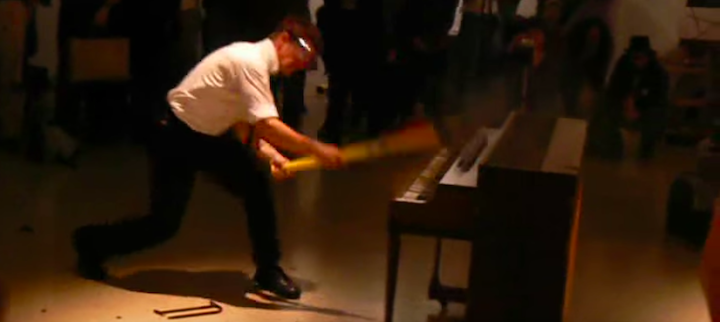Something interesting has been happening this year at Bird & Beckett, a bookstore in San Francisco’s tranquil Excelsior neighborhood. Lisa Mezzacappa‘s latest sextet has been running an extended workshop, putting on jazz salons every couple of months around a new set of material. It’s going to culminate in a two-set performance of the polished pieces on Nov. 3.
The songs are based on Italo Calvino’s Cosmicomics, a clutch of stories reimagining cosmology in Calvino’s fantastical way. Based on Mezzacappa’s descriptions and one passage she read aloud, the stories are both philosophical and whimsical, sometimes knowingly absurd.
It’s the latest in a series of terrific theme-based projects by Mezzacappa. In 2017, she released avantNOIR (Clean Feed), cool and jazzy pieces inspired by Dashiell Hammett. Glorious Ravage, based on the journals of 19th-century female explorers, was a spellbinding live performance that was eventually captured on CD (New World, 2017).
The sextet for Cosmicomics is a crew who have worked with Mezzacappa and one another for years: Aaron Bennett (sax), John Finkbeiner (guitar), Jordan Glenn (drums), Tim Perkis (electronics), Mark Clifford (vibes), and Mezzacappa on bass. These are springy, dancing free-jazz compositions with strong themes and plenty of room for exploration. The vibes add shimmering atmosphere, and Perkis’ laptop sounds slide into the music naturally, whether as accompaniment or soloing.
There’s an abstract element to setting written-word “moods” to music, but Calvino’s stories gave Mezzacappa some hooks to follow literally. “All at One Point” (and you’ll have to forgive me if I’m getting the story titles or plots mixed up) supposes that before the big bang, when all of the universe was condensed into a zero-dimensional dot, all of the people were living together in that one point. Don’t worry about the physics; this is a fairy tale! Anyway, it’s a crowded place, but one popular, beautiful woman comes up with the idea of spreading out, to create space. And they do — hence the big bang — but no one ever sees the woman again.
Musically, this gets realized with a single note played by band members in unison. Then they gradually diverge, matching the concept of the universe separating, creating freedom while losing the comfortable order of the single point.
Another of the stories concerns three particles endlessly falling in the pre-matter void of the universe. Mezzacappa read a passage that pointed out the particles could, in fact, be rising instead of falling — who’s to say, considering there’s no universe? The story is a love triangle, with the narrator particle dreading that he might be falling away from his would-be mistress. Mezzacappa turned this into a trio improv game of pursuit and pursuers.
Other songs follow a more conventional jazzy flow, as with “The Soft Moon” in the video above. It’s a bit light, a bit swingy, a bit off-center. If I remember it right, the namesake story is based on the “theory” that the moon is a thick semifluid, and portions of it occasionally glop down onto Earth to form things like the continents.
The only Calvino I’ve managed to read is Invisible Cities, but that gave me a good feel for his imagination. He’s way out there, but with a matter-of-fact voice that’s almost folksy, miles away from the usual tones of sci-fi or fantasy. I’d sought out Calvino because so many musicians seemed to be dedicating pieces to him — Ken Vandermark, among them — and I can see why his voice, like an Alexander Calder sculpture, would be inspiring to artists of any stripe.
Mezzacappa’s next Bird & Beckett performance will be on Thursday, Sept. 13.
